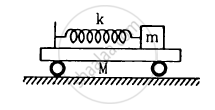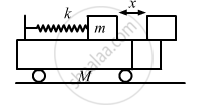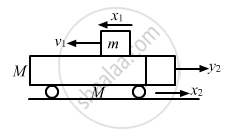Advertisements
Advertisements
प्रश्न
All the surfaces shown in figure are frictionless. The mass of the care is M, that of the block is m and the spring has spring constant k. Initially the car and the block are at rest and the spring is stretched through a length x0 when the system is released. (a) Find the amplitudes of the simple harmonic motion of the block and of the care as seen from the road. (b) Find the time period(s) of the two simple harmonic motions.

उत्तर
Let x1 and x2 be the amplitudes of oscillation of masses m and M respectively.
(a) As the centre of mass should not change during the motion, we can write:
mx1 = Mx2 \[\ldots(1)\]
Let k be the spring constant. By conservation of energy, we have:
\[\frac{1}{2}k x_0^2 = \frac{1}{2}k \left( x_1 + x_2 \right)^2 \ldots(2)\]
where x0 is the length to which spring is stretched.
From equation (2) we have,
\[x_0 = x_1 + x_2 \]
On substituting the value of x2 from equation (1) in equation (2), we get:
\[x_0 = x_1 + \frac{m x_1}{M}\]
\[ \Rightarrow x_0 = \left( 1 + \frac{m}{M} \right) x_1 \]
\[ \Rightarrow x_1 = \left( \frac{M}{M + m} \right) x_0\]
\[\text { Now }, x_2 = x_0 - x_1 \]
On substituting the value of x1 from above equation, we get:
\[\Rightarrow x_2 = x_0 \left[ 1 - \frac{M}{M + m} \right]\]
\[ \Rightarrow x_2 = \frac{m x_0}{M + m}\]
Thus, the amplitude of the simple harmonic motion of a car, as seen from the road is

Let v1 and v2 be the velocities.
Using law of conservation of energy we have,
Now, from the principle of conservation of momentum, we have:
Mx2 = mx1
\[\Rightarrow x_1 = \left( \frac{M}{m} \right) x_2 . . . . \left( 4 \right)\]
\[M v_2 = m\left( v_1 - v_2 \right)\]
\[ \Rightarrow \left( v_1 - v_2 \right) = \left( \frac{M}{m} \right) v_2 . . . . \left( 5 \right)\]
Putting the above values in equation (3), we get:
\[\frac{1}{2}M v_2^2 + \frac{1}{2}m\frac{M^2}{m^2} v_2^2 + \frac{1}{2}k x_2^2 \left( 1 + \frac{M}{m} \right)^2 = \text { constant }\]
\[ \therefore M\left( 1 + \frac{M}{m} \right) v_2^2 + k\left( 1 + \frac{M}{m} \right) x_2^2 = \text { constant } \]
\[ \Rightarrow M v_2^2 + k\left( 1 + \frac{M}{m} \right) x_2^2 = \text { constant } \]
Taking derivative of both the sides, we get:
\[M \times 2 v_2 \frac{d v_2}{dt} + k\left( \frac{M + m}{m} \right)2 x_2 \frac{d x_2}{dt} = 0\]
\[ \Rightarrow m a_2 + k\left( \frac{M + m}{m} \right) x_2 = 0 \left[ \text { because }, v_2 = \frac{d x_2}{dt} \right]\]
\[\frac{a_2}{x_2} = \frac{- k\left( M + m \right)}{Mm} = \omega^2 \]
\[ \therefore \omega = \sqrt{\frac{k\left( M + m \right)}{Mm}}\]
\[\text { Therefore, time period }, T = 2\pi\sqrt{\frac{Mm}{k\left( M + m \right)}}\]

APPEARS IN
संबंधित प्रश्न
Define phase of S.H.M.
Assuming the expression for displacement of a particle starting from extreme position, explain graphically the variation of velocity and acceleration w.r.t. time.
Show variation of displacement, velocity, and acceleration with phase for a particle performing linear S.H.M. graphically, when it starts from the extreme position.
Can the potential energy in a simple harmonic motion be negative? Will it be so if we choose zero potential energy at some point other than the mean position?
The time period of a particle in simple harmonic motion is equal to the time between consecutive appearances of the particle at a particular point in its motion. This point is
The distance moved by a particle in simple harmonic motion in one time period is
A pendulum clock keeping correct time is taken to high altitudes,
Suppose a tunnel is dug along a diameter of the earth. A particle is dropped from a point, a distance h directly above the tunnel. The motion of the particle as seen from the earth is
(a) simple harmonic
(b) parabolic
(c) on a straight line
(d) periodic
An object is released from rest. The time it takes to fall through a distance h and the speed of the object as it falls through this distance are measured with a pendulum clock. The entire apparatus is taken on the moon and the experiment is repeated
(a) the measured times are same
(b) the measured speeds are same
(c) the actual times in the fall are equal
(d) the actual speeds are equal
A particle executes simple harmonic motion with an amplitude of 10 cm and time period 6 s. At t = 0 it is at position x = 5 cm going towards positive x-direction. Write the equation for the displacement x at time t. Find the magnitude of the acceleration of the particle at t = 4 s.
Assume that a tunnel is dug across the earth (radius = R) passing through its centre. Find the time a particle takes to cover the length of the tunnel if (a) it is projected into the tunnel with a speed of \[\sqrt{gR}\] (b) it is released from a height R above the tunnel (c) it is thrown vertically upward along the length of tunnel with a speed of \[\sqrt{gR}\]
A simple pendulum of length l is suspended through the ceiling of an elevator. Find the time period of small oscillations if the elevator (a) is going up with and acceleration a0(b) is going down with an acceleration a0 and (c) is moving with a uniform velocity.
A hollow sphere of radius 2 cm is attached to an 18 cm long thread to make a pendulum. Find the time period of oscillation of this pendulum. How does it differ from the time period calculated using the formula for a simple pendulum?
A particle is subjected to two simple harmonic motions given by x1 = 2.0 sin (100π t) and x2 = 2.0 sin (120 π t + π/3), where x is in centimeter and t in second. Find the displacement of the particle at (a) t = 0.0125, (b) t = 0.025.
What is meant by simple harmonic oscillation? Give examples and explain why every simple harmonic motion is a periodic motion whereas the converse need not be true.
Consider a simple pendulum of length l = 0.9 m which is properly placed on a trolley rolling down on a inclined plane which is at θ = 45° with the horizontal. Assuming that the inclined plane is frictionless, calculate the time period of oscillation of the simple pendulum.
A body oscillates with SHM according to the equation x = 5 cos `(2π"t" + π/4)`. Its instantaneous displacement at t = 1 sec is:
A spring is stretched by 5 cm by a force of 10 N. The time period of the oscillations when a mass of 2 kg is suspended by it is ______.
A body having specific charge 8 µC/g is resting on a frictionless plane at a distance 10 cm from the wall (as shown in the figure). It starts moving towards the wall when a uniform electric field of 100 V/m is applied horizontally toward the wall. If the collision of the body with the wall is perfectly elastic, then the time period of the motion will be ______ s.

